“Foresight is 20/20” is not a typographical error. Rather, it relates to a theme that Dr. Terri Elton and I wrote about in our recent book, Leading Congregations and Nonprofits in a Connected World: Platforms, People, and Purpose. Foresight is one capacity that will enable congregations to thrive in the future. The velocity of change is accelerating so swiftly that even being agile is insufficient insurance for future survival. Agility, which involves pivoting to a change, still places leaders in a reactive mode. But when leaders learn how to regularly exercise and act upon foresight, they’ll have a better chance to proactively shape the future of their congregations.
When do we invoke the phrase “20/20 hindsight?”
We do so to make sense of how we either missed an opportunity or threat. But 20/20 foresight suggests that we can turn knowledge of what is very likely to happen in the future into practices of what can be now. With 20/20 foresight, congregational leaders can focus more on igniting people’s spiritual sparks instead of “worrying about how to keep the lights on.” They’ll have a better chance at deepening and broadening their mission and positively influencing more people’s spiritual lives.
Hard trends and future facts
In our book, we described several processes that leaders can use to peer further over the horizon and anticipate potential issues, policies, and innovations. Since that time, I’ve become more familiar with Dr. Daniel Burrus, a global innovation expert and futurist, and his most recent book The Anticipatory Organization: Turn Disruption And Change Into Opportunity And Advantage. Burrus introduces two interrelated concepts for getting smart about the future: “hard trends” and “future facts.” He writes, “A hard trend is a future fact that can provide something that is very empowering: certainty. Hard trends will happen, no matter who you are…. None of us can stop hard trends from occurring, but there are ways to see them coming.” Once you’ve become better at identifying “hard trends,” you can use “future facts” to your advantage because your congregation will already be where its existing and potential constituents are.
Here are two examples of hard trends that are future facts:
These two hard trends – six generations alive at one time and a VR world – are replete with spiritual implications that anticipatory leaders could be acting upon now. For example, how do we foster ongoing intergenerational relationships where young and old engage in reciprocal learning? What happens to our innate holiness when children grow up with “parents” named Alexa and Cortana? There are few venues in our communities that are structured for ongoing interactions between young and old (and “old” means 55+!) but that’s also a great opportunity for congregations. They are theoretically ready to become spaces of intergenerational meeting, where puzzling through these issues becomes normative.
A true story to concretize this opportunity
A 14-year-old teen whose grandmother was diagnosed with early Alzheimer’s disease raised money by crowdfunding to develop an app with AI (artificial intelligence) and facial recognition software to help her grandmother remember family members. This teen initiated conversations and sought ideas and support from caregivers, family members, and tech mentors by herself. You can read this story in Adele Peters article “A 14-Year-Old Made An App To Help Alzheimer’s Patients Recognize Their Loved Ones” from Fast Company. Given their access to multiple generations and talented volunteers, congregations could create a standing intergenerational council to harness the wisdom, technological savvy and multiple generational perspectives to address opportunities and rapid changes. Congregations also have the advantage of drawing upon inherited spiritual wisdom to weigh advantages and disadvantages of maintaining the status quo versus initiating a change.
Finding a balance
The capacity to better envision the future is admittedly difficult. Religious leaders must calibrate the balance between our inherited spiritual past and contemporary realities so that future generations will inherit a spiritual legacy. That sounds like an impossible task, but the routine act of driving a car suggested an analogy of how we already do so. When driving, we balance past, present and future because we learn when to accelerate forward and when to slow down and brake, while simultaneously looking ahead through the windshield, behind through the rearview mirror, and at our present surroundings in the side view mirrors.
As religious leaders, we bring humility to our efforts to better anticipate the future, which holds mysteries beyond our perception and imagination. On the other hand, the greatest religious leaders have been rooted in the past, looked deeply into the present, and provided a vision for the future. Speaking from the Jewish tradition, I’m inspired by a question that a first-century rabbinic sage, Rabban Yochanan ben Zakkai, asked a group of his students. “Which is the best characteristic for a person to acquire?” One student, Rabbi Shimon, said “One should learn to anticipate the future.” His response can empower us to think more about the hard trends and future facts that we can use to keep congregations vital.


